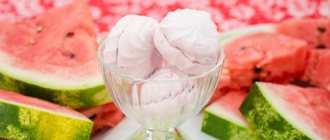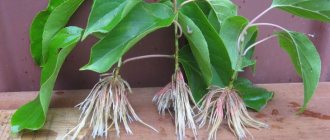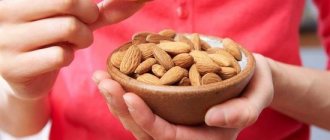Features of reception during breastfeeding
The introduction of cocoa during breastfeeding in the first days after birth is possible:
Condition No. 1.
You drank cocoa during pregnancy (especially in the third trimester). You do not have any allergic reactions to products (including during pregnancy).
Make a serving half your usual size. Use milk that is not too fat or skim, 2.5-3% is ideal. You can use any milk you like (cow's milk, coconut milk, almond milk, etc.). Drink the drink in the first half of the day and see if the baby shows any reaction.
There is a reaction - you postpone the introduction of cocoa for a month, then follow the same pattern.
There is no reaction - add it to your diet, but no more than 3-4 cups per week.
Condition No. 2.
You did not drink cocoa during pregnancy. You have allergic reactions to food.
The first introduction of the drink is possible when the baby reaches 2 months. The portion and recommendations are the same as in Condition No. 1.
Possible reactions of the child: rash, redness of the skin, itching, diarrhea, constipation, intestinal colic (bloating).
Lifehack:
in case of an unbearable desire to drink a mug of cocoa, without exposing your child to any negative reactions, give yourself this opportunity, express milk with a reserve of 3-4 days and satisfy your need. While the baby is eating expressed milk, you also need to express so that lactation continues at the same rhythm, just in this case, you pour out all the milk that you expressed.
Replace the need for chocolate with magnesium-containing vitamins and products: dried fruit compote and bananas are allowed for consumption by nursing mothers from the first days after birth.
In order to reduce the entry of traces of the drink into the child’s body, it is necessary to follow the feeding regime. Infants in the first half of the year need milk every 3-4 hours.
More frequent breastfeeding disrupts the digestive system and does not give the mother the opportunity to enjoy a new allergenic, but valuable product immediately after feeding. If the child does not react, you can continue to use it, observing the rule of maximum-distant feeding.
Daily consumption of dessert during lactation immediately after morning feeding will have a positive effect on the mother’s well-being. At this time, you should carefully monitor the baby's reaction. Drinking the drink more often than once a day is not recommended, as the likelihood of an allergic reaction is greater and the effect on the central nervous system is more noticeable.
Important! You can drink cocoa drink during lactation if the mother observes feeding intervals and the baby is in good health.
Useful properties of cocoa
Cocoa is a high-vitamin drink, containing vitamins A, E, PP, B, as well as minerals: zinc, iron, sodium, potassium, magnesium, calcium. A high-quality product consists mostly of proteins and fats, which are easily absorbed by the body and restore it.
The drink has a greater strengthening and tonic effect on the body, but contains less caffeine. It improves physical performance and stimulates brain activity, which is important for the weakened body of a nursing mother.
The drink saturates the heart muscles, improves metabolism, improves digestion and the functioning of the pancreas. Its consumption in summer helps protect against sunburn and provide a beautiful tan. In autumn, winter, and spring, it helps prevent flu and colds, thanks to its general strengthening and tonic effect. The presence of antioxidants protects against radiation and the formation of cancer cells. The drink normalizes the circulatory system and cleanses blood vessels of plaque.
Important! The beneficial qualities of cocoa cannot have a therapeutic effect; they have a general strengthening, preventive effect.
Properties of cocoa
The calorie content of the product is 300 kcal per 100 grams. The powder contains useful substances:
- vegetable fats and proteins;
- saturated fatty acids;
- fibers;
- starch;
- sucrose;
- carbohydrates.
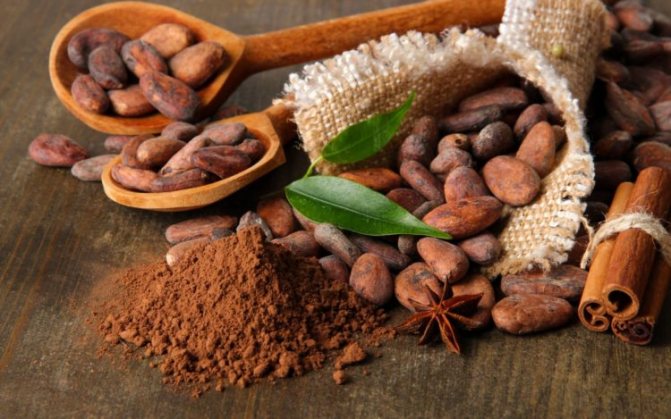
Cocoa contains many beneficial elements
Cocoa fruits are rich in mineral compounds and vitamins:
- B vitamins;
- sodium;
- potassium;
- magnesium;
- vitamin A;
- beta-carotene;
- iron;
- vitamin E;
- chlorine;
- sulfur;
- phosphorus compounds;
- zinc
Regardless of the beneficial components of the product, rashes may appear on the baby’s body during breastfeeding. Therefore, before using the drink, it is recommended to compare its benefits and harm to the baby.
Benefits and harms
Can a nursing mother have cocoa while breastfeeding? The answer depends on many factors:
- child health;
- predisposition to allergies;
- functionality of the gastrointestinal tract;
- baby's age.
Cocoa is characterized by positive and negative effects on the body of a nursing woman and her child. The product is useful for its properties:
- acts as an antidepressant;
- promotes cell regeneration;
- strengthens the cardiovascular system;
- normalizes the amount of cholesterol in the bloodstream;
- activates blood circulation in brain structures;
- strengthens blood vessels, which normalizes blood pressure;
- acts as an antioxidant;
- slows down age-related changes;
- eliminates inflammation in the body.
The drink prevents stroke. Hot cocoa provokes overexcitation of the nervous system, which is due to the presence of caffeine in cocoa beans. It is advisable to limit the intake of the drink to children under 3 years of age. For older children, it is recommended to dilute the powder with milk or cream. It is recommended to take the treat in the first half of the day.

It is necessary to carefully monitor the child's reaction when consuming cocoa.
Contraindications
It is not advisable to take the drink if the mother or baby has contraindications:
- diabetes;
- atherosclerotic formations;
- for disturbances in the functioning of the digestive tract;
- gout;
- reduced functionality of the excretory system.
If a child has allergic manifestations, it is recommended to refrain from drinking the drink, since it is difficult to determine the reaction of a small organism to a new product.
Contraindications

Cocoa is harmful for diseases of the endocrine system, gout, high blood sugar, kidney failure, and allergies. For such ailments, the doctor prescribes a special diet.
If a person is generally allergic, it is quite possible that there is no negative reaction to cocoa. The test should be carried out when there are no signs of irritation in the body or on the skin.
It is not recommended to give cocoa drinks, chocolate, or sweets to children under three years of age due to the strong effect on the central nervous system. Babies often need a calming effect rather than a stimulating effect.
Pediatricians prohibit cocoa-containing products for nursing mothers. This is due to traces of the drink entering the baby’s body through breast milk. The central nervous system is excited and the child’s gastrointestinal tract is irritated. But proper use of the drink will help reduce its negative effects to a minimum. It is difficult for nursing mothers to give up chocolate, and cocoa will become a complete substitute, but without sugar, milk fats and preservatives.
Important! If you have any disease, you should consult your doctor before drinking the drink.
How to choose

It is necessary to distinguish cocoa drink from a natural product. The first option does not need to be cooked, it contains sugar and just needs to be dissolved in milk. In this case, the cocoa drink dissolves even in cold liquid.
Natural cocoa contains only cocoa powder, no sugar or other additives. It requires proper preparation: first boil 100 ml of milk or water, pour 1 tbsp of liquid. l. powder, stir and get a paste-like mixture, which is poured into 200 ml of milk or water and brought to a boil, cooked for 5 minutes over low heat. This drink has a natural taste and smell of chocolate. For a nursing mother, it is better to dilute the milk drink with water. Good cocoa, even prepared entirely in water with the addition of a spoonful of milk, has excellent taste.
When choosing between different manufacturers, you should pay attention to the country of origin. Cocoa beans grow in Africa (Ivory Coast), Indonesia, Nigeria, Brazil, Malaysia, Colombia. You should not buy a product from a Chinese manufacturer, there are no cocoa beans, they buy and process low-quality raw materials, obtaining a cheap product.
Important! The higher the fat content of cocoa (from 10 to 25%), the tastier the drink. But nursing mothers should choose a product with medium fat content.
Cocoa during breastfeeding
During pregnancy and breastfeeding, a woman chooses her diet with special attention. This is justified by the close relationship between the nutrition of a young mother and the health of the child. Can a nursing mother have cocoa? Or should you avoid this healthy but allergenic drink during pregnancy and breastfeeding?
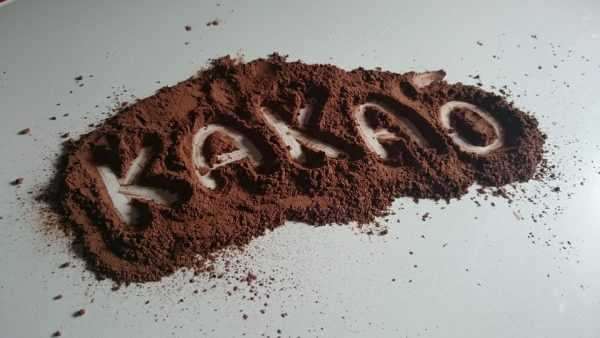
Useful properties of cocoa
Cocoa, compared to tea and coffee, is a less harmful but healthier drink. It has a greater strengthening, tonic effect on the body, but at the same time contains less caffeine. It improves physical performance and stimulates brain activity, which is important for the weakened body of a young mother.
Cocoa is a high-vitamin drink. It contains vitamins A, E, PP, B, as well as minerals: zinc, iron, sodium, potassium, magnesium, calcium. A high-quality product consists mostly of proteins and fats, which are easily absorbed by the body and restore it.
The drink saturates the heart muscles, improves metabolism, improves digestion and the functioning of the pancreas. Drinking this drink in summer helps protect against sunburn and give you a beautiful tan. In autumn, winter, spring - helps prevent flu and colds, thanks to its general strengthening and tonic effect. The presence of antioxidants protects against radiation and the formation of cancer cells. The drink normalizes the circulatory system and cleanses blood vessels of plaque.
Important! The beneficial properties of cocoa cannot have a therapeutic effect; they have a general strengthening, preventive effect. They are more effective with an integrated approach to the problem.
Contraindications

Cocoa is harmful for diseases of the endocrine system, gout, high blood sugar, kidney failure, and allergies. For such diseases, the doctor prescribes a special diet.
If a person is generally allergic, it is quite possible that there is no negative reaction to cocoa. The test should be carried out when there are no signs of irritation in the body or on the skin.
It is not recommended to give cocoa drinks, chocolate, or sweets to children under three years of age due to the strong effect on the central nervous system. Children more often need a calming effect than a stimulating effect.
Pediatricians prohibit cocoa-containing products for nursing mothers. This is due to traces of the product entering the baby's body through breast milk. The central nervous system is excited and the child’s gastrointestinal tract is irritated. But with proper use of the drink, you can reduce its impact to a minimum. It’s hard for women to give up chocolate, and cocoa is a complete substitute, but without sugar, milk fats and preservatives.
Important! If you have any disease before consuming cocoa, you should consult your doctor.
How to choose cocoa
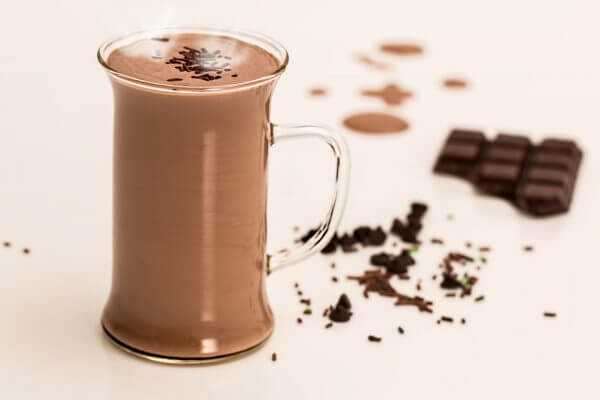
First of all, it is necessary to distinguish cocoa drink from natural cocoa. The first option does not need to be cooked, it contains sugar and just needs to be dissolved in milk. In this case, the temperature of the milk does not matter, since the chemical drink dissolves even in cold water.
Natural cocoa contains only cocoa powder, no sugar or other additives. It requires proper preparation: first boil 100 ml of milk or water, then pour in a tbsp. l. cocoa powder, stir and get a mushy mixture, which is poured into 200 ml of milk or water and brought to a boil, cooked for 5 minutes over low heat. This drink has a natural taste and smell of chocolate. Can a nursing mother have cocoa with milk? It is better to dilute it with water; good cocoa, even prepared entirely in water with the addition of a spoonful of milk, has excellent taste.
When choosing between different cocoa producers, you should pay attention to the country of origin. Cocoa beans grow in Africa (Ivory Coast), Indonesia, Nigeria, Brazil, Malaysia, Colombia. You should not buy cocoa from a Chinese manufacturer, there are no cocoa beans, they buy and process low-quality raw materials, so they get a cheap product.
Important! The higher the cocoa fat content, from 10 to 25%, the tastier the drink. But nursing mothers should choose a product with medium fat content.







